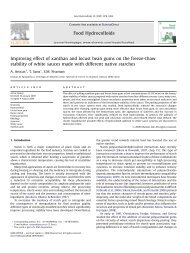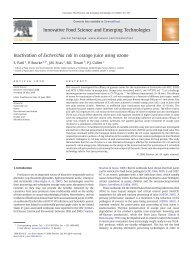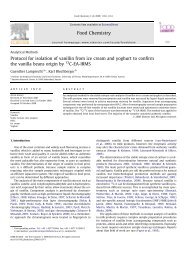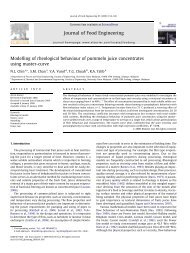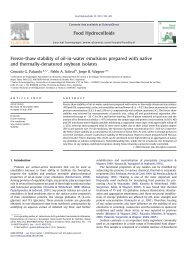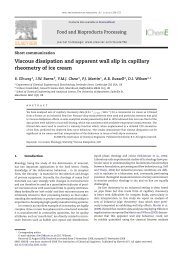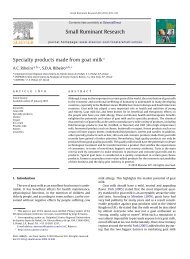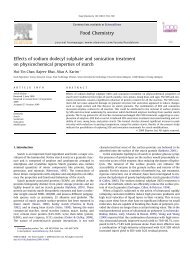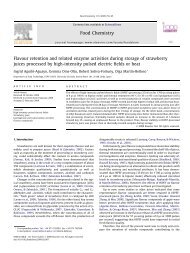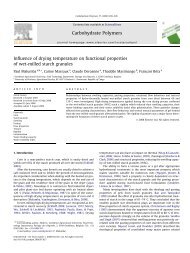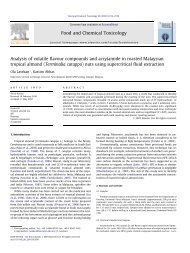Solid-state fermentation of apple pomace using Phanerocheate ...
Solid-state fermentation of apple pomace using Phanerocheate ...
Solid-state fermentation of apple pomace using Phanerocheate ...
You also want an ePaper? Increase the reach of your titles
YUMPU automatically turns print PDFs into web optimized ePapers that Google loves.
<strong>Solid</strong>-<strong>state</strong> <strong>fermentation</strong> <strong>of</strong> <strong>apple</strong> <strong>pomace</strong> <strong>using</strong> <strong>Phanerocheate</strong> chrysosporium<br />
– Liberation and extraction <strong>of</strong> phenolic antioxidants<br />
C.M. Ajila a , S.K. Brar a,⇑ , M. Verma b , R.D. Tyagi a , J.R. Valéro a<br />
a INRS-ETE, Université du Québec, 490, Rue de la Couronne, Québec, Canada G1K 9A9<br />
b Institut de recherche et de développement en agroenvironnement inc. (IRDA), 2700 rue Einstein, Québec, Canada G1P 3W8<br />
article info<br />
Article history:<br />
Received 24 August 2010<br />
Received in revised form 25 October 2010<br />
Accepted 19 November 2010<br />
Available online 26 November 2010<br />
Keywords:<br />
<strong>Solid</strong>-<strong>state</strong> <strong>fermentation</strong><br />
<strong>Phanerocheate</strong> chrysosporium<br />
Apple <strong>pomace</strong><br />
Phenolic compounds<br />
Antioxidants<br />
1. Introduction<br />
abstract<br />
There is an increasing global trend towards the efficient utilisation<br />
<strong>of</strong> natural resources. The direct disposal <strong>of</strong> agro industrial<br />
by-products as a waste in the environment represents a major<br />
cause for environmental pollution and also an important loss <strong>of</strong><br />
biomass which could be used for the production <strong>of</strong> different<br />
metabolites with added commercial value (Vendruscolo, Pitol,<br />
Koch, & Ninow, 2007). Sustainable food production and valueaddition<br />
<strong>of</strong> wastes is the most important issue in the agro and food<br />
processing industry. Apple and <strong>apple</strong> products are one <strong>of</strong> the major<br />
fruit and fruit products consumed all over the world. Several million<br />
tonnes <strong>of</strong> <strong>apple</strong> <strong>pomace</strong> are generated during the processing<br />
<strong>of</strong> <strong>apple</strong> products, such as <strong>apple</strong> juice, jelly, cider, among others<br />
(Bhushan, Kalia, Sharma, Singh, & Ahuja, 2008), which contributes<br />
about 20–35% <strong>of</strong> the total fruit production. Apple <strong>pomace</strong> has been<br />
used as a source for several applications, such as pectin recovery<br />
(Schieber et al., 2003), enzyme production (Favela-Torres, Volke,<br />
& Viniegra, 2006), animal feed (Sehm, Lindermayer, Dummer,<br />
Treutter, & Pfaffl, 2007), organic acids production (Shojaosadati &<br />
⇑ Corresponding author. Address: Institut national de la recherche scientifique<br />
Centre Eau, Terre & Environnement/Centre for Water, Earth and Environment 490<br />
de la Couronne, Québec (Qc), Canada G1K 9A9. Tel.: +1 418 654 3116; fax: +1 418<br />
654 2600.<br />
E-mail address: satinder.brar@ete.inrs.ca (S.K. Brar).<br />
0308-8146/$ - see front matter Ó 2010 Elsevier Ltd. All rights reserved.<br />
doi:10.1016/j.foodchem.2010.11.129<br />
Food Chemistry 126 (2011) 1071–1080<br />
Contents lists available at ScienceDirect<br />
Food Chemistry<br />
journal homepage: www.elsevier.com/locate/foodchem<br />
Apple <strong>pomace</strong> is a by-product from the <strong>apple</strong> processing industry and can be used for the production <strong>of</strong><br />
value-added phenolic compounds. A study was carried out to understand the changes and liberation <strong>of</strong><br />
phenolic compounds and improvement in antioxidant activity during solid-<strong>state</strong> <strong>fermentation</strong> <strong>of</strong> <strong>apple</strong><br />
<strong>pomace</strong> <strong>using</strong> <strong>Phanerocheate</strong> chrysosporium. The solid-<strong>state</strong> <strong>fermentation</strong> <strong>of</strong> <strong>apple</strong> <strong>pomace</strong> <strong>using</strong> P. chrysosporium<br />
mobilised the polyphenolic compounds and improved the nutraceutical properties. The polyphenol<br />
content in acetone extract increased and the results were statistically significant (P < 0.05) from<br />
4.6 to 16.12 mg GAE/g dry weight during solid-<strong>state</strong> <strong>fermentation</strong>. The effect <strong>of</strong> various solvents, temperature,<br />
time and detergents were also investigated for the extraction <strong>of</strong> polyphenolics by ultrasonication<br />
and microwave-assisted extraction methods. The polyphenol content <strong>of</strong> the extracts was found to be in<br />
the range <strong>of</strong> 5.78–16.12 mg GAE/g DW <strong>of</strong> samples, depending on the solvent, extraction time and temperature.<br />
Antioxidant activities <strong>of</strong> polyphenol extracts were tested <strong>using</strong> the 2,2-diphenyl-1-picryhydrazyl<br />
(DPPH) radical methods, where the IC50 ranged from 12.24 to 23.42 lg DW sample, depending on the<br />
extraction conditions and the antioxidant activities correlated well with the polyphenol concentrations.<br />
Ó 2010 Elsevier Ltd. All rights reserved.<br />
Babaeipour, 2002), ethanol production (Paganini, Nogueira, Silva,<br />
& Wosiacki, 2005), aroma compounds (Medeiros, Pandey, Vandenberghe,<br />
Pastore, & Soccol, 2006), natural antioxidants (Foo & Lu,<br />
1999), among others.<br />
Diets rich in fruits and vegetables are gaining increased importance<br />
due to their significant role in reducing the risk <strong>of</strong> certain<br />
types <strong>of</strong> cancer, cardiovascular diseases and other chronic diseases<br />
(Joshipura et al., 2001; McCann et al., 2007; Suárez et al., 2010).<br />
Fruits and vegetables contain many antioxidant compounds<br />
including phenolic compounds, carotenoids, anthocyanins and tocopherols<br />
(Naczk & Shahidi, 2006). Apple is an important source <strong>of</strong><br />
bioavailable polyphenols, such as flavonols, monomeric and oligomeric<br />
flavonols, dihydrochalcones, anthocyanidins, as well as others<br />
(Escarpa & Gonzalez, 1998). The most abundant polyphenols<br />
present in <strong>apple</strong>s are chlorogenic acid, phloretin glucosides and<br />
quercetin glucosides (Wijngaard, R€ossle, & Brunton, 2009). Other<br />
polyphenolic compounds, such as catechins and procyanidins, have<br />
also been identified, but are present in relatively small amounts<br />
(Foo & Lu, 1999). The polyphenolic compound contents vary<br />
greatly among different varieties and various parts <strong>of</strong> <strong>apple</strong>s; <strong>apple</strong><br />
peels contain a higher concentration <strong>of</strong> phenolic compounds than<br />
the flesh (Vrhosek, Rigo, Tonan, & Mattivi, 2004). Owing to the<br />
increasing interest in new natural sources <strong>of</strong> antioxidant products,<br />
<strong>apple</strong> <strong>pomace</strong> has been investigated as a potential source <strong>of</strong><br />
bioactive polyphenols during recent years (Cetkovic et al., 2008),<br />
which have many applications in food, pharmaceutical and
1072 C.M. Ajila et al. / Food Chemistry 126 (2011) 1071–1080<br />
cosmetic industry by virtue <strong>of</strong> its antioxidant and antimicrobial<br />
activities.<br />
While the potential <strong>of</strong> <strong>apple</strong> <strong>pomace</strong> as a source <strong>of</strong> polyphenols<br />
seems clear, there is less information on potential strategies for the<br />
recovery <strong>of</strong> these compounds. Most <strong>of</strong> the polyphenolic compounds<br />
are present in a bound form with carbohydrates, such as<br />
glycosides in nature. This bound nature <strong>of</strong> polyphenolics as glycosides<br />
reduces their ability to function as good antioxidants (Vattem<br />
& Shetty, 2003). The lowered antioxidant activity has a direct effect<br />
on the health functionality when these compounds are ingested<br />
into the body via food or nutraceuticals, and may have to depend<br />
on the probiotic status <strong>of</strong> the digestive system (Vattem & Shetty,<br />
2003). Therefore, the release <strong>of</strong> free phenolics can improve the<br />
health functionality <strong>of</strong> these phytochemicals. Many ligninolytic<br />
and carbohydrate metabolising enzymes are produced by fungi<br />
during <strong>fermentation</strong> <strong>of</strong> lignocellulosic wastes. These enzymes can<br />
hydrolyse the phenolic glycosides and can release the free<br />
aglycones, potentially having high antioxidant activity, making<br />
them very useful for applications in food and beverage industries<br />
(Vattem & Shetty, 2003).<br />
In the present investigation, the ability <strong>of</strong> white rot fungi,<br />
<strong>Phanerocheate</strong> chrysosporium to release phenolic antioxidants from<br />
<strong>apple</strong> <strong>pomace</strong> by solid-<strong>state</strong> <strong>fermentation</strong> has been studied. The<br />
extraction <strong>of</strong> polyphenolics from <strong>apple</strong> <strong>pomace</strong> and fermented <strong>apple</strong><br />
<strong>pomace</strong> was carried out by ultrasonic assisted extraction and<br />
microwave-assisted extraction methods. The optimisation <strong>of</strong> solvents,<br />
extraction time, extraction temperature, power and effect<br />
<strong>of</strong> non-ionic surfactants for the extraction <strong>of</strong> polyphenolics has also<br />
been investigated.<br />
2. Materials and methods<br />
Apple <strong>pomace</strong> samples from the <strong>apple</strong> processing industry, Lassonde<br />
Inc., Rougemont, Montreal, Canada was collected and used<br />
as the solid substrate for the solid-<strong>state</strong> <strong>fermentation</strong>. All chemicals<br />
required for the experiments have been purchased from Fisher<br />
Scientific (Fisher Scientific Company, Ontario, Canada), VWR chemicals<br />
(VWR international, Quebec, Canada) and Sigma Chemicals<br />
(Sigma–Aldrich Canada Ltd., Ontario, Canada) and were <strong>of</strong> analytical<br />
grade.<br />
2.1. <strong>Solid</strong>-<strong>state</strong> <strong>fermentation</strong><br />
Medium for <strong>fermentation</strong>: Apple <strong>pomace</strong> was used as natural substrate<br />
for the solid-<strong>state</strong> <strong>fermentation</strong>. The <strong>apple</strong> <strong>pomace</strong> solids<br />
were stored at 20 °C for its conservation prior to use. For the <strong>fermentation</strong>,<br />
<strong>apple</strong> <strong>pomace</strong> was treated with inducers, such as copper<br />
sulphate (2 mM), veratryl alcohol (2 mM) and Tween-80 (0.1%), before<br />
the pH was adjusted to 4.5 and it was sterilised in an autoclave<br />
for 30 min at 121 ± 1 °C. The moisture content in the <strong>apple</strong> <strong>pomace</strong><br />
was 72% w/v. P. Chrysosporium was propagated and stored at<br />
20 °C, according to the procedure developed by Gassara, Brar,<br />
Tyagi, Verma, and Surampalli (2010). The concentration <strong>of</strong> spore<br />
suspension used in the experiments was 2.5 10 6 spores/g <strong>of</strong> solid.<br />
<strong>Solid</strong>-<strong>state</strong> <strong>fermentation</strong>: The <strong>fermentation</strong> was carried out in<br />
flasks. The media in flasks were autoclaved at 121 ± 1 °C for<br />
30 min. The inoculation was performed <strong>using</strong> the spore suspension.<br />
The <strong>fermentation</strong> was carried out in a controlled environment<br />
with temperature at 37 ± 1 °C for 14 days.<br />
2.2. Ultrasonic assisted extraction <strong>of</strong> polyphenolic compounds<br />
Apple <strong>pomace</strong> and fermented <strong>apple</strong> <strong>pomace</strong> were accurately<br />
weighed to 1 g and 20 ml <strong>of</strong> solvents was added. The samples were<br />
placed in an ultrasonication bath (Elma Hans Schmidhauer GmbH<br />
& Co. KG, Germany). The optimisation <strong>of</strong> solvents for the extraction<br />
<strong>of</strong> phenolics by ultrasonication was carried out <strong>using</strong> different solvents,<br />
such as water; 60% ethanol; 70% ethanol, 80% ethanol; 60%<br />
acetone; 70% acetone and 80% acetone; 60% methanol; 70% methanol<br />
and 80% methanol. The ultrasonic extraction was performed<br />
for 30 min at 40 ± 1 °C. The optimisation <strong>of</strong> time for the extraction<br />
<strong>of</strong> phenolics was carried out <strong>using</strong> different solvents, such as water,<br />
80% acetone and 80% alcohol. Duplicates <strong>of</strong> each sample were<br />
extracted at different time intervals <strong>of</strong> 20, 30 and 40 min at 40 °C.<br />
The optimisation <strong>of</strong> temperature for the extraction <strong>of</strong> phenolics<br />
was performed <strong>using</strong> water. Duplicates <strong>of</strong> each sample were extracted<br />
at different temperatures <strong>of</strong> 30, 40, 50, 60, 70 and 80 °C<br />
for 30 min. The effect <strong>of</strong> Tween-20 as a surfactant for the extraction<br />
<strong>of</strong> polyphenolics was carried out <strong>using</strong> different concentrations <strong>of</strong><br />
Tween-20, such as 0.1%, 1%, 2% and 5% in v/v with water.<br />
For each <strong>of</strong> the optimisation experiments, duplicates <strong>of</strong> each<br />
sample were extracted at the same time. Each sample mixture<br />
was centrifuged at 9268g for 20 min to obtain the supernatant.<br />
The supernatant was used for determination <strong>of</strong> total phenolics<br />
content.<br />
2.3. Microwave-assisted extraction <strong>of</strong> polyphenolic compounds<br />
Apple <strong>pomace</strong> and fermented <strong>apple</strong> <strong>pomace</strong> were accurately<br />
weighed to 1 g and 20 ml <strong>of</strong> solvent was added. Each mixture<br />
was taken in a sealed 100 ml green chem Teflon reactor vessel<br />
and extracted for 10 min at 60 °C with a pressure <strong>of</strong> 692 kpa and<br />
power 400 W, <strong>using</strong> a sophisticated microwave extractor (Mars,<br />
CEM Corporation, Northcarolina, USA). The microwave extractor<br />
allowed highly accurate control <strong>of</strong> pressure, power and temperature.<br />
After 10 min <strong>of</strong> extraction, vessels were allowed to cool prior<br />
to their removal from the extractor. Duplicates <strong>of</strong> each sample<br />
were extracted and each sample mixture was centrifuged at<br />
9268g for 20 min to obtain the supernatant. The optimisation <strong>of</strong><br />
solvents, extraction time, temperature and effect <strong>of</strong> detergents<br />
for the extraction <strong>of</strong> phenolics was performed <strong>using</strong> the same protocol<br />
as for ultrasonication.<br />
2.4. Estimation <strong>of</strong> total phenolic content<br />
The content <strong>of</strong> total polyphenolics in the phenolic extract <strong>of</strong> <strong>apple</strong><br />
<strong>pomace</strong> and fermented <strong>apple</strong> <strong>pomace</strong> was determined by the method<br />
<strong>of</strong> Swain and Hillis (1959). The supernatant obtained after centrifugation<br />
<strong>of</strong> ultrasonic and microwave-assisted extraction was used<br />
for the determination <strong>of</strong> total phenolics content. The absorbance<br />
was recorded at 725 nm. Gallic acid was used as a standard. The content<br />
<strong>of</strong> total polyphenolics in the extract was expressed as gallic acid<br />
equivalents (GAE) in g/dry weight <strong>of</strong> the samples.<br />
2.5. Free radical scavenging activity <strong>of</strong> polyphenolic compounds<br />
The effect <strong>of</strong> polyphenol extracts on DPPH radical was determined<br />
according to the method by Brand-Williams, Cuvelier, and<br />
Berset (1995). A 100 lM solution <strong>of</strong> DPPH in methanol was prepared<br />
and polyphenol extract (200 ll) was mixed with 1 ml <strong>of</strong><br />
DPPH solution. The mixture was shaken vigorously and left in<br />
the dark at room temperature for 20 min. The absorbance <strong>of</strong> the<br />
resulting solution was measured at 517 nm. The control contained<br />
all the reagents except the polyphenol extract. The capacity to<br />
scavenge DPPH radical was calculated by following Equation:<br />
Scavenging activityð%Þ ¼½1 ðAs=A0ÞŠ 100 ð1Þ<br />
where A0 is the absorbance at 517 nm <strong>of</strong> the control and As is the<br />
absorbance in the presence <strong>of</strong> polyphenol extract. The results<br />
were plotted as the percentage <strong>of</strong> scavenging activity against<br />
concentration <strong>of</strong> the sample. The half-inhibition concentration
(IC50) was defined as the amount <strong>of</strong> sample in dry weight required<br />
for 50% <strong>of</strong> free radical scavenging activity. The IC 50 value was calculated<br />
from the plots as the antioxidant concentration required for<br />
providing 50% free radical scavenging activity.<br />
2.6. Statistical analyses<br />
All the experiments were conducted in triplicates and data presented<br />
are an average <strong>of</strong> triplicates along with the standard deviation.<br />
Statistical analysis was done for the parameters, such as<br />
extraction methods, solvents, time and effect <strong>of</strong> detergents, to find<br />
out the optimum conditions for polyphenolic extraction and antioxidant<br />
activities. The database was subjected to an analysis <strong>of</strong><br />
variance (ANOVA) and multiple range tests among data were carried<br />
out <strong>using</strong> the Statistical Analysis System S<strong>of</strong>tware (STAT-<br />
GRAPHICS Centurion, XV trial version 15.1.02 year 2006,<br />
StatPoint, Inc. USA). The results which have P < 0.05 were considered<br />
as significant. The method used to discriminate among the<br />
means is Fisher’s least significant difference (LSD) procedure. Using<br />
this method, there is a 5.0% risk <strong>of</strong> calling each pair <strong>of</strong> means significantly<br />
different when the actual difference equals 0.<br />
3. Results and discussion<br />
The polyphenol content in <strong>apple</strong> <strong>pomace</strong> and fermented <strong>apple</strong><br />
<strong>pomace</strong> was determined. It was found that the polyphenol content<br />
increased from 15.53 to 17.2 mg GAE/g dry weight (DW) <strong>of</strong> samples<br />
depending on the solvent used, extraction time and temperature.<br />
Antioxidant activities <strong>of</strong> polyphenol extracts were tested<br />
<strong>using</strong> the 2,2-diphenyl-1-picryhydrazyl (DPPH) radical methods<br />
and the IC50 ranged from 12.24 to 23.42 lg DW sample, depending<br />
on the extraction conditions and the antioxidant activities, correlated<br />
well with the polyphenol concentrations. Extraction <strong>of</strong> polyphenols<br />
by vortexing the sample with water, 80% acetone and 80%<br />
ethanol was done as control experiment for the extraction techniques,<br />
such as ultrasonication and microwave digestion. The polyphenol<br />
content in water, 80% acetone and 80% ethanol was 1.24,<br />
5.6 and 4.2 mg GAE/g dry weight sample. The polyphenol extraction<br />
by vortexing was very low compared to other extraction<br />
methods. Thus, further experiments on the optimisation <strong>of</strong> parameters<br />
were conducted mainly <strong>using</strong> ultrasonication and microwave-assisted<br />
extraction methods. The effect <strong>of</strong> solvents,<br />
temperature, time and detergents during the extraction <strong>of</strong> polyphenolics<br />
by ultrasonic and microwave-assisted extraction methods<br />
was studied for the development <strong>of</strong> better extraction and<br />
recovery method for polyphenolics.<br />
The ultrasonic extraction is a simple and rapid method for the<br />
extraction and fractionation <strong>of</strong> plant materials. The ultrasonication<br />
was principally ascribed to mechanical and chemical effects <strong>of</strong><br />
acoustic wave, which break the biological cell and facilitate the<br />
release <strong>of</strong> cell contents into the extraction medium (Toma,<br />
Vinatoru, & Mason, 2001). Further, the cell fragmentation dramatically<br />
increases the contact areas and accelerates the mass transfer<br />
rate <strong>of</strong> target extracts into the extraction solvent. Microwaveassisted<br />
extraction is a faster extraction process, where microwave<br />
energy is efficiently delivered to materials through molecular<br />
interaction with the electromagnetic field and <strong>of</strong>fers a rapid transfer<br />
<strong>of</strong> energy to the extraction solvent and raw plant materials<br />
(Zhou & Liu, 2006).<br />
3.1. Optimisation <strong>of</strong> solvents for the extraction <strong>of</strong> polyphenolics <strong>using</strong><br />
ultrasonic and microwave extraction<br />
The average total polyphenol contents <strong>of</strong> <strong>apple</strong> <strong>pomace</strong> and fermented<br />
<strong>apple</strong> <strong>pomace</strong> extracts tested for different solvents such as<br />
C.M. Ajila et al. / Food Chemistry 126 (2011) 1071–1080 1073<br />
water, Ethanol 60%, Ethanol 70%, Ethanol 80%, Acetone 60%, Acetone<br />
70%, Acetone 80%, Methanol 60%, Methanol 70% and Methanol 80%<br />
by ultrasonication and microwave extraction are presented in<br />
Fig. 1A and B. Acetone (80%) extracted a significantly higher amount<br />
<strong>of</strong> phenolic compounds (P < 0.05) compared to other solvents, such<br />
as acetone, methanol, ethanol and water. The extractability <strong>of</strong> polyphenols<br />
by the different solvents followed used the order: acetone<br />
80% > acetone 70% > acetone 60% > ethanol 80% > ethanol 70% ><br />
ethanol 60% > methanol 80% > methanol 70% > methanol 60% ><br />
water, as shown in the Fig. 1A and B. The average total phenol content<br />
<strong>of</strong> acetone 80% extract (16.12 mg GAE/g DW) was at least three<br />
times higher than that <strong>of</strong> aqueous extracts (5.78 mg GAE/g DW) and<br />
was statistically significant (P < 0.05).<br />
Water, methanol and ethanol were found to be inefficient for<br />
the extraction <strong>of</strong> polyphenolics compared to acetone by both ultrasonic<br />
and microwave extraction methods. The phenolic compounds<br />
in the extracts are more <strong>of</strong>ten associated with other<br />
biomolecules, such as protein, carbohydrates, lipids, terpenes,<br />
chlorophyll and other organic compounds. Hence, there should<br />
be a better solvent for extracting the polyphenolic compounds. It<br />
has been already reported that ethanol/water or acetone/water extracted<br />
better when compared to either ethanol or acetone alone<br />
(Yilmaz & Toledo, 2006) during the extraction <strong>of</strong> grape seed polyphenolics.<br />
The aqueous extraction <strong>of</strong> polyphenolics leaves a large<br />
amount <strong>of</strong> residual polyphenols which can be extracted only by<br />
an appropriate combination <strong>of</strong> solvents. The polyphenol content<br />
in aqueous extraction was very low compared to other solvents<br />
in both the extraction methods. The main drawback <strong>of</strong> the aqueous<br />
extraction is the low yield in antioxidants, with low polarity or<br />
lipo-soluble antioxidants. Solubility <strong>of</strong> polyphenols depends<br />
mainly on the hydroxyl groups, the molecular size and the length<br />
<strong>of</strong> hydrocarbon. Zhou and Yu (2004) reported that among the solvents<br />
tested, 50% acetone extracts contained a higher level <strong>of</strong> total<br />
phenolics from wheat whereas, ethanol was the least effective solvent,<br />
which is also in agreement with our results. In the study carried<br />
out by Yu, Ahmedna, and Goktepe (2005), 80% ethanol and 80%<br />
methanol were found to be more efficient than water for extracting<br />
total phenolics from peanut skin, which is also in concordance with<br />
the results from this study.<br />
The free radical scavenging activity <strong>of</strong> polyphenol extracts from<br />
<strong>apple</strong> <strong>pomace</strong> and fermented <strong>apple</strong> <strong>pomace</strong> with different solvents<br />
by ultrasonic assisted and microwave-assisted extraction was measured<br />
as IC 50 value and the results are shown in Table 1. Solvents<br />
used for polyphenol extraction also had significant effects on DPPH<br />
scavenging capacity determination for polyphenol extracts from<br />
<strong>apple</strong> <strong>pomace</strong> and fermented <strong>apple</strong> <strong>pomace</strong> (Table 1). DPPH method<br />
is a widely used method for antioxidant activity studies. The<br />
method is based on the reduction <strong>of</strong> alcoholic DPPH solutions at<br />
517 nm, in the presence <strong>of</strong> a hydrogen donating antioxidant (Koleva,<br />
Van Beek, Linssen, De Groot, & Evstatieva, 2002) and polyphenols<br />
have been reported to be potent hydrogen donors to the DPPH<br />
radical because <strong>of</strong> their ideal structural chemistry (Rice-Evans, Miller,<br />
& Paganga, 1997). The polyphenol extracts with 80% acetone as a<br />
solvent, in both <strong>apple</strong> <strong>pomace</strong> and fermented <strong>apple</strong> <strong>pomace</strong> by<br />
ultrasonication and microwave extraction methods, showed significantly<br />
higher DPPH radical scavenging activity (P < 0.05) than<br />
those with other solvents and this trend was similar to that observed<br />
for polyphenol content. The IC 50 values obtained from the<br />
polyphenol extract by ultrasonic assisted extraction varied significantly<br />
(P < 0.05) from 24.43 to 52.96 lg DW and 14.27 to<br />
50.18 lg DW for <strong>apple</strong> <strong>pomace</strong> and fermented <strong>apple</strong> <strong>pomace</strong>,<br />
respectively, as shown in the Table 1. Acetone extract (80%) <strong>of</strong> both<br />
<strong>apple</strong> <strong>pomace</strong> and fermented <strong>apple</strong> <strong>pomace</strong> exhibited higher inhibitory<br />
activity against DPPH radical in comparison with their corresponding<br />
solvent extracts. This can be attributed to a higher<br />
concentration <strong>of</strong> polyphenolics present in the extract. In both the
1074 C.M. Ajila et al. / Food Chemistry 126 (2011) 1071–1080<br />
Fig. 1. Optimisation <strong>of</strong> solvent for extraction <strong>of</strong> polyphenolics: (A) by ultrasonication and; (B) by microwave extraction. Values are expressed as means <strong>of</strong> three<br />
replicates ± standard deviations; means indicated with different letters differ significantly (P < 0.05).<br />
Table 1<br />
Effect <strong>of</strong> solvents on free radical scavenging activity <strong>of</strong> <strong>apple</strong> <strong>pomace</strong> and fermented <strong>apple</strong> <strong>pomace</strong> polyphenol extract by ultrasonic and microwave-assisted extraction.<br />
Solvents Ultrasonic assisted extraction Microwave-assisted extraction<br />
Apple <strong>pomace</strong> (IC50 in lg) Fermented <strong>apple</strong> <strong>pomace</strong> (IC50 in lg) Apple <strong>pomace</strong> (IC50 in lg) Fermented <strong>apple</strong> <strong>pomace</strong> (IC50 in lg)<br />
Water 52.96 ± 2.50 j<br />
50.18 ± 2.00 j<br />
42.24 ± 2.20 i<br />
40.16 ± 2.40 i<br />
Ethanol 60% 37.09 ± 1.80 h<br />
27.68 ± 2.00 ef<br />
32.46 ± 3.40 g<br />
25.46 ± 3.20 e<br />
Ethanol 70% 28.83 ± 1.80 f<br />
26.96 ± 2.20 ef<br />
25.24 ± 2.80 e<br />
22.42 ± 3.20 d<br />
Ethanol 80% 26.04 ± 4.20 ef<br />
25.74 ± 2.40 e<br />
22.38 ± 4.20 d<br />
20.14 ± 2.70 c<br />
Methanol 60% 30.99 ± 3.40 g<br />
27.68 ± 1.40 ef<br />
24.46 ± 4.40 e<br />
22.14 ± 3.80 d<br />
Methanol 70% 25.55 ± 2.60 e<br />
26.21 ± 2.60 ef<br />
22.52 ± 4.60 d<br />
20.56 ± 2.20 c<br />
Methanol 80% 23.43 ± 2.20 d<br />
20.59 ± 2.10 c<br />
20.80 ± 2.10 c<br />
18.26 ± 2.40 b<br />
Acetone 60% 26.04 ± 1.40 ef<br />
25.74 ± 2.80 e<br />
24.42 ± 4.20 e<br />
22.38 ± 4.30 d<br />
Acetone 70% 25.02 ± 4.20 e<br />
17.19 ± 1.60 b<br />
20.64 ± 2.60 c<br />
14.25 ± 2.80 a<br />
Acetone 80% 24.43 ± 1.80 e<br />
14.27 ± 2.50 a<br />
20.12 ± 2.40 c<br />
12.24 ± 5.20 a<br />
IC50 values were calculated from the dose responses curves. All data are the mean ± SD <strong>of</strong> three replicates. Mean followed by different letters in the same column differ<br />
significantly (P < 0.05) between the parameters such as solvent, extraction method and <strong>fermentation</strong>. Bold cells represent optimal values.<br />
<strong>apple</strong> <strong>pomace</strong> and fermented <strong>apple</strong> <strong>pomace</strong>, the order <strong>of</strong> radical<br />
scavenging activity was : 80% acetone > 80% methanol > 70% acetone<br />
> 70% methanol > 60% acetone > 80% ethanol > 70% ethanol<br />
> 60% methanol > 60% ethanol > water.<br />
The IC 50 values obtained from the polyphenol extract by microwave-assisted<br />
extraction varied from 20.12 to 42.24 lg DW and<br />
12.24 to 40.16 lg DW for <strong>apple</strong> <strong>pomace</strong> and fermented <strong>apple</strong> <strong>pomace</strong>,<br />
respectively. Acetone extract (80%) <strong>of</strong> both <strong>apple</strong> <strong>pomace</strong> and<br />
fermented <strong>apple</strong> <strong>pomace</strong> exhibited higher and significant inhibi-<br />
tory activity (P < 0.05) against DPPH radical as in the case <strong>of</strong> ultrasonic<br />
assisted extraction.<br />
In both the <strong>apple</strong> <strong>pomace</strong> and fermented <strong>apple</strong> <strong>pomace</strong>, the order<br />
<strong>of</strong> radical scavenging activity was: 80% acetone > 70% acetone<br />
> 80% methanol > 80% ethanol > 70% methanol > 60%<br />
acetone > 60% methanol > 70% ethanol > 60% ethanol > water. The<br />
polyphenolic extracts by microwave-assisted extraction<br />
(12.24 lg DW) showed higher free radical scavenging activity than<br />
the extract by ultrasonic assisted extraction (14.27 lg DW). The
higher values <strong>of</strong> free radical activity may be due to the higher phenolic<br />
contents extracted by microwave extraction, compared to<br />
ultrasonication.<br />
The UV spectra <strong>of</strong> the polyphenolic extracts with different solvents<br />
have been analysed. Fig. 2 shows UV spectra <strong>of</strong> the polyphenolic<br />
extracts with different solvents. The result shows the good<br />
agreement between experimental polyphenol content data and<br />
the UV spectral analysis <strong>of</strong> polyphenol extracts between 200 and<br />
600 nm. It should be clearly understood that the UV spectra verified<br />
the extraction <strong>of</strong> polyphenolic extract <strong>of</strong> <strong>apple</strong> <strong>pomace</strong> and <strong>apple</strong><br />
<strong>pomace</strong> based on spectral differences among the polyphenolic<br />
compounds extracted by different solvents.<br />
3.2. Optimisation <strong>of</strong> time for the extraction <strong>of</strong> polyphenolics by<br />
ultrasonic and microwave extraction<br />
The polyphenol content and free radical scavenging activity <strong>of</strong><br />
polyphenol extracts with ultrasonication and microwave-assisted<br />
extraction at different time intervals is shown in Fig. 3A and B<br />
and Table 2. In the first stage <strong>of</strong> extraction, the total phenol content<br />
and free radical scavenging activity especially increased with<br />
extraction time in both ultrasonic assisted extraction and microwave-assisted<br />
extraction. In ultrasonic assisted extraction, the<br />
phenolic extraction was maximum at 30 min <strong>of</strong> extraction. The<br />
phenolic content in <strong>apple</strong> <strong>pomace</strong> increased from 1.41 to<br />
2.81 mg GAE/g DW, 4.68 to 5.72 mg GAE/g DW and 8.13 to<br />
12.28 mg GAE/g DW in water, 80% ethanol and 80% methanol,<br />
respectively. In the case <strong>of</strong> fermented <strong>apple</strong> <strong>pomace</strong>, total phenol<br />
content increased significantly (P < 0.05) from 6.74 to<br />
9.76 mg GAE/g DW, 11.34 to 13.46 mg GAE/g DW and 18.97 to<br />
19.90 mg GAE/g DW in water, 80% ethanol and 80%, methanol,<br />
respectively. After 30 min <strong>of</strong> extraction, the phenolic content<br />
decreased.<br />
C.M. Ajila et al. / Food Chemistry 126 (2011) 1071–1080 1075<br />
Microwave assisted phenolic extraction was carried out at different<br />
time intervals, such as 5, 10 and 15 min and the maximum<br />
extraction was obtained in 10 min <strong>of</strong> extraction. The phenolic content<br />
in <strong>apple</strong> <strong>pomace</strong> increased from 9.52 to 10.82 mg GAE/g DW,<br />
10.69 to 15.72 mg GAE/g DW and 14.53 to 18.28 mg GAE/g DW in<br />
water, 80% ethanol and 80% methanol, respectively at 10 min<br />
<strong>of</strong> extraction. In the case <strong>of</strong> fermented <strong>apple</strong> <strong>pomace</strong>, total<br />
phenol content increased significantly (P < 0.05) from 10.26 to<br />
14.24 mg GAE/g DW, 11.28 to 17.24 mg GAE/g DW and 14.46 to<br />
20.12 mg GAE/g DW in water, 80% ethanol and 80% methanol,<br />
respectively, as shown in the Fig. 3A and B.<br />
The extraction time impacted DPPH scavenging capacity determination<br />
for polyphenol extracts from <strong>apple</strong> <strong>pomace</strong> and fermented<br />
<strong>apple</strong> <strong>pomace</strong>. The free radical scavenging activity <strong>of</strong><br />
polyphenol extracts from <strong>apple</strong> <strong>pomace</strong> and fermented <strong>apple</strong> <strong>pomace</strong><br />
with different extraction times by ultrasonic assisted and<br />
microwave-assisted extraction was measured as IC50 value and<br />
the results are shown in Table 1. The IC50 values obtained from<br />
the polyphenol extract by ultrasonic assisted extraction varied<br />
from 24.43 to 28.24 lg DW and 14.27 to 18.24 lg DW for <strong>apple</strong><br />
<strong>pomace</strong> and fermented <strong>apple</strong> <strong>pomace</strong>, respectively. The IC 50 values<br />
obtained from the polyphenol extract by microwave-assisted<br />
extraction varied from 20.12 to 24.32 lg DW and 12.24 to<br />
16.38 lg DW for <strong>apple</strong> <strong>pomace</strong> and fermented <strong>apple</strong> <strong>pomace</strong>,<br />
respectively. The free radical scavenging activity increased with<br />
enlarged extraction time and later it decreased in both ultrasonication<br />
and microwave-assisted extraction. At 30 min extraction, <strong>apple</strong><br />
<strong>pomace</strong> and fermented <strong>apple</strong> <strong>pomace</strong> exhibited higher and<br />
more significant inhibitory activity against DPPH radical in comparison<br />
with 20 and 40 min for ultrasonic assisted extraction with<br />
other solvent extracts. The antioxidant activity was significantly<br />
different for the corresponding extraction time (P < 0.05). In fact,<br />
in the case <strong>of</strong> microwave-assisted extraction, 10 min extraction<br />
Fig. 2. UV–Visible spectra <strong>of</strong> polyphenolic extracts <strong>using</strong> different solvents (80% acetone, 80% ethanol, 80% methanol and water).
1076 C.M. Ajila et al. / Food Chemistry 126 (2011) 1071–1080<br />
Fig. 3. Optimisation <strong>of</strong> extraction time for polyphenolics: (A) by ultrasonication and; (B) by microwave extraction. Values are expressed as means <strong>of</strong> three<br />
replicates ± standard deviations; means indicated with different letters differ significantly (P < 0.05).<br />
Table 2<br />
Effect <strong>of</strong> extraction time on free radical scavenging activity <strong>of</strong> <strong>apple</strong> <strong>pomace</strong> and fermented <strong>apple</strong> <strong>pomace</strong> polyphenol extract <strong>of</strong> 80% acetone by ultrasonic and microwaveassisted<br />
extraction.<br />
Time (min) Ultrasonic assisted extraction Microwave-assisted extraction<br />
Apple <strong>pomace</strong> (IC50 in lg) Fermented <strong>apple</strong> <strong>pomace</strong> (IC50 in lg) Apple <strong>pomace</strong> (IC50 in lg) Fermented <strong>apple</strong> <strong>pomace</strong> (IC50 in lg)<br />
5 – – 24.32 ± 2.80 f<br />
16.38 ± 2.90 c<br />
10 – – 20.12 ± 2.40 e<br />
12.24 ± 5.20 a<br />
15 – – 22.14 ± 2.60 e<br />
15.67 ± 4.30 b<br />
20 28.24 ± 2.60 h<br />
18.24 ± 5.20 d<br />
–<br />
30 24.43 ± 1.80 f<br />
14.27 ± 2.50 b<br />
–<br />
40 26.21 ± 2.60 g<br />
16.34 ± 4.20 c<br />
–<br />
IC50 values were calculated from the dose responses curves. All data are the mean ± SD <strong>of</strong> three replicates. Mean followed by different letters in the same column differ<br />
significantly (P < 0.05) between the parameters such as extraction methods, temperature and <strong>fermentation</strong>. Bold cells represent optimal values.<br />
showed higher antioxidant activity compared to 5 and 15 min<br />
extraction. This can be attributed to higher concentration <strong>of</strong> polyphenolics<br />
present in the extract.<br />
Extraction time affected the total phenolic content and antioxidant<br />
activities. The decrease in polyphenolic content and antioxidant<br />
activity after particular extraction time may be due to the<br />
chemical and enzymatic degradation, which in turn affects the polyphenol<br />
content and its antioxidant activity (Larrauri, Ruperez, &<br />
Saura-Calixto, 1997). It has been suggested that polyphenols can<br />
react with other plant components and decompose to form other<br />
less active phenolic contents (Guillot, Malnoë, & Stadler, 1996). It<br />
was also found that a longer extraction time increases the chance<br />
<strong>of</strong> oxidation <strong>of</strong> phenolics, unless reducing agents are added to<br />
the solvent system, which reduces the antioxidant activity (Naczk<br />
& Shahidi, 2006).<br />
3.3. Optimisation <strong>of</strong> temperature for the extraction <strong>of</strong> polyphenolics in<br />
ultrasonic and microwave extraction<br />
Extraction temperature is one <strong>of</strong> the important factors affecting<br />
the extraction efficiency <strong>of</strong> polyphenols. The yield <strong>of</strong> polyphenol<br />
extraction can be obtained at higher temperature. High temperature
solvent will promote distribution <strong>of</strong> polysaccharides in the cell wall<br />
so that more solvent can be contacted with polyphenols (Sun, Chu,<br />
Wu, & Liu, 2002).<br />
Fig. 4A and B show the effect <strong>of</strong> temperature for the ultrasonic<br />
and microwave assisted polyphenol extraction, for different<br />
extraction temperatures ranging from 30 to 80 °C. Fig. 4A shows<br />
that in the ultrasonic assisted extraction, with the increase <strong>of</strong> temperature<br />
from 30–40 °C, the polyphenol concentration increased<br />
significantly (P < 0.05) from 7.1 mg GAE/g DW to 9.2 mg GAE/<br />
g DW, then reached the peak, and finally dropped from 50 to<br />
80 °C. In the case <strong>of</strong> microwave-assisted extraction, the polyphenol<br />
content increased significantly (P < 0.05) with temperature from<br />
40 to 60 °C and slowly dropped after 60 °C as shown in Fig. 4B.<br />
The extraction temperature also led to important effects on<br />
DPPH scavenging capacity determination for polyphenol extracts<br />
from <strong>apple</strong> <strong>pomace</strong> and fermented <strong>apple</strong> <strong>pomace</strong>. The free radical<br />
scavenging activity <strong>of</strong> polyphenol extracts from <strong>apple</strong> <strong>pomace</strong> and<br />
fermented <strong>apple</strong> <strong>pomace</strong>, with different extraction temperatures<br />
ranging from 30 to 80 °C, by ultrasonic assisted and microwave-assisted<br />
extraction, was measured as IC50 value and the results are<br />
shown in Table 3. The IC 50 values obtained from the aqueous polyphenol<br />
extract by ultrasonic assisted extraction varied from 52.96<br />
to 58.11 lg DW and 50.22 to 56.26 lg DW for <strong>apple</strong> <strong>pomace</strong> and<br />
fermented <strong>apple</strong> <strong>pomace</strong>, respectively. The IC50 values obtained<br />
C.M. Ajila et al. / Food Chemistry 126 (2011) 1071–1080 1077<br />
from the polyphenol extract by microwave-assisted extraction varied<br />
from 42.24 to 51.48 lg DW and 40.16 to 48.45 lgDW<br />
(P < 0.05) for <strong>apple</strong> <strong>pomace</strong> and fermented <strong>apple</strong> <strong>pomace</strong>, respectively.<br />
The free radical scavenging activity increased with increase<br />
in extraction temperature and it was a maximum at optimum<br />
extraction temperature and later it decreased in both ultrasonication<br />
and microwave-assisted extraction. At 40 °C, both <strong>apple</strong> <strong>pomace</strong><br />
and fermented <strong>apple</strong> <strong>pomace</strong> exhibited higher and more<br />
significant inhibitory activity (P < 0.05) against DPPH by ultrasonic<br />
assisted extraction. Meanwhile, in the case <strong>of</strong> microwave-assisted<br />
extraction, extraction at 60 °C showed higher antioxidant activity<br />
compared to other temperatures.<br />
The phenomenon <strong>of</strong> increase in polyphenol content with increase<br />
in temperature could be due to the fact that with the increase<br />
in temperature, solvent viscosity declined and the<br />
movement <strong>of</strong> molecules gets accelerated, which in turn led to<br />
the dissolution <strong>of</strong> polyphenols with the increase <strong>of</strong> diffusion coefficient<br />
and stability. However, much higher temperature will cause<br />
the loss <strong>of</strong> solvent, resulting in a lower yield and also promoting<br />
the oxidation <strong>of</strong> polyphenols, which in turn affect the free radical<br />
scavenging activity <strong>of</strong> the extract. Increased extraction <strong>of</strong> polyphenolic<br />
groups with increasing temperature can be attributed to rapid<br />
mass transfer <strong>of</strong> the solutes (Schwartzberg, Torres, & Zaman,<br />
1982) and increased solubility, especially <strong>of</strong> polymeric fractions,<br />
Fig. 4. Optimisation <strong>of</strong> temperature for extraction <strong>of</strong> polyphenolics: (A) by ultrasonication and; (B) by microwave extraction. Values are expressed as means <strong>of</strong> three<br />
replicates ± standard deviations; means indicated with different letters differ significantly (P < 0.05).
1078 C.M. Ajila et al. / Food Chemistry 126 (2011) 1071–1080<br />
Table 3<br />
Effect <strong>of</strong> temperature on free radical scavenging activity <strong>of</strong> <strong>apple</strong> <strong>pomace</strong> and fermented <strong>apple</strong> <strong>pomace</strong> polyphenol aqueous extract by ultrasonic and microwave-assisted<br />
extraction.<br />
Solvents Ultrasonic assisted extraction Microwave-assisted extraction<br />
Apple <strong>pomace</strong> (IC50 in lg) Fermented <strong>apple</strong> <strong>pomace</strong> (IC50 in lg) Apple <strong>pomace</strong> (IC50 in lg) Fermented <strong>apple</strong> <strong>pomace</strong> (IC50 in lg)<br />
30 54.26 ± 4.20 f<br />
53.28 ± 2.20 f<br />
51.28 ± 3.20 e<br />
48.26 ± 3.80 d<br />
40 52.96 ± 2.50 ef<br />
51.22 ± 1.80 e<br />
50.24 ± 1.60 e<br />
46.24 ± 2.40 c<br />
50 53.28 ± 3.60 f<br />
50.18 ± 2.00 e<br />
46.28 ± 2.80 c<br />
42.14 ± 2.80 b<br />
60 54.46 ± 3.90 f<br />
52.24 ± 1.70 ef<br />
42.24 ± 2.20 b<br />
40.16 ± 2.40 a<br />
70 56.24 ± 1.20 g<br />
54.48 ± 1.40 f<br />
45.64 ± 3.20 c<br />
44.92 ± 2.70 c<br />
80 58.11 ± 2.30 h<br />
56.26 ± 2.40 g<br />
51.28 ± 4.20 e<br />
48.45 ± 3.30 d<br />
IC 50 values were calculated from the dose responses curves. All data are the mean ± SD <strong>of</strong> three replicates. Mean followed by different letters in the same column differ<br />
significantly (P < 0.05) between extraction methods, time and <strong>fermentation</strong>. Bold cells represent optimal values.<br />
Fig. 5. Effect <strong>of</strong> Tween-20 on extraction <strong>of</strong> polyphenolics: (A) by ultrasonication and; (B) by microwave extraction. Values are expressed as means <strong>of</strong> three<br />
replicates ± standard deviations; means indicated with different letters differ significantly (P < 0.05).<br />
at higher temperatures. Therefore, the optimal extraction temperature<br />
was considered to be 40 °C for ultrasonic assisted extraction<br />
and 60 °C for microwave-assisted extraction.<br />
3.4. Effect <strong>of</strong> Tween-20 on extraction <strong>of</strong> polyphenolics <strong>using</strong> ultrasonic<br />
and microwave extraction<br />
The effect <strong>of</strong> surfactants on polyphenolic extraction was studied<br />
<strong>using</strong> Tween-20 with different concentrations ranging from 0.1% to<br />
5% v/v in aqueous extract by ultrasonic and microwave-assisted<br />
extraction methods and the results are given in Fig. 5A and B.<br />
Tween-20 is a polysorbate surfactant, which is both relatively sta-<br />
ble and non-toxic, and is used as a detergent and emulsifier in<br />
many domestic, scientific and pharmacological applications. 1%<br />
v/v <strong>of</strong> Tween-20 increased the polyphenol extraction in both ultrasonic<br />
assisted and microwave-assisted extraction. The effect <strong>of</strong><br />
these surfactants on free radical scavenging activity <strong>of</strong> aqueous<br />
polyphenol extracts from <strong>apple</strong> <strong>pomace</strong> and fermented <strong>apple</strong> <strong>pomace</strong><br />
with different concentrations ranging from 0.1 to 5% v/v by<br />
ultrasonic assisted and microwave-assisted extraction was measured<br />
as IC50 value and the results are shown in Table 4. The IC50<br />
values obtained from the aqueous polyphenol extract by ultrasonic<br />
assisted extraction varied from 46.14 to 52.96 lg DW and 45.24 to<br />
50.18 lg DW for <strong>apple</strong> <strong>pomace</strong> and fermented <strong>apple</strong> <strong>pomace</strong>,
Table 4<br />
Effect <strong>of</strong> Tween-20 on free radical scavenging activity <strong>of</strong> <strong>apple</strong> <strong>pomace</strong> and fermented <strong>apple</strong> <strong>pomace</strong> polyphenol extract by ultrasonic and microwave-assisted extraction.<br />
Tween 20 (%) Ultrasonic assisted extraction Microwave-assisted extraction<br />
Apple <strong>pomace</strong> (IC50 in lg) Fermented <strong>apple</strong> <strong>pomace</strong> (IC50 in lg) Apple <strong>pomace</strong> (IC50 in lg) Fermented <strong>apple</strong> <strong>pomace</strong> (IC50 in lg)<br />
0 52.96 ± 2.50 g<br />
50.18 ± 2.00 f<br />
42.24 ± 2.20 c<br />
40.16 ± 2.40 bc<br />
0.1 48.26 ± 3.80 e<br />
47.71 ± 1.20 e<br />
41.62 ± 3.20 bc<br />
38.22 ± 2.20 b<br />
1 46.14 ± 2.20 d<br />
45.24 ± 4.10 d<br />
39.64 ± 2.80 b<br />
35.42 ± 3.60 a<br />
2 48.28 ± 3.20 e<br />
46.45 ± 2.80 d<br />
42.33 ± 3.60 c<br />
38.44 ± 4.20 b<br />
5 51.26 ± 5.20 f<br />
48.22 ± 4.10 e<br />
45.26 ± 3.20 d<br />
42.28 ± 2.80 c<br />
respectively. The IC50 values obtained from the polyphenol extract<br />
by microwave-assisted extraction varied from 39.64 to 45.26 lg<br />
DW and 35.42 to 42.28 lg DW for <strong>apple</strong> <strong>pomace</strong> and fermented<br />
<strong>apple</strong> <strong>pomace</strong>, respectively. Aqueous polyphenol extract <strong>of</strong> <strong>apple</strong><br />
<strong>pomace</strong> and fermented <strong>apple</strong> <strong>pomace</strong> with 1% v/v Tween-20<br />
exhibited statistically significant higher inhibitory activity<br />
(P < 0.05) against DPPH by both microwave and ultrasonic assisted<br />
extraction.<br />
Tween-20 might have enhanced the extraction <strong>of</strong> polyphenols<br />
due to two factors: (a) lowering surface tension and hence enhancing<br />
the release <strong>of</strong> polyphenols especially entrapped in the complex<br />
solid matrix; and (b) facilitating increased reaction rate due to the<br />
increased contact between surfactant, polyphenols and other components<br />
in the liquid phase. In fact, Tween has been commonly<br />
used as a surfactant and extractant in many applications, including<br />
proteins, cells, as well as others (Umesaki, Kawai, & Mutai, 1977)<br />
4. Conclusion<br />
The present study showed that the enrichment <strong>of</strong> <strong>apple</strong> <strong>pomace</strong><br />
with phenolic antioxidants can be carried out by solid-<strong>state</strong> <strong>fermentation</strong><br />
<strong>using</strong> white rot fungus, <strong>Phanerocheate</strong> chrysosporium.<br />
The phenolic content was higher in fermented <strong>apple</strong> <strong>pomace</strong> than<br />
the <strong>apple</strong> <strong>pomace</strong> and the antioxidant activity was correlated with<br />
the increase in polyphenolic content. The extraction <strong>of</strong> polyphenol<br />
content varied depending on the type <strong>of</strong> solvent, temperature <strong>of</strong><br />
extraction, extraction time and the method used. <strong>Solid</strong>-<strong>state</strong> <strong>fermentation</strong><br />
thus, not only resulted in value addition to the <strong>apple</strong><br />
<strong>pomace</strong>, but also improved the antioxidant activity.<br />
Acknowledgements<br />
The authors are sincerely thankful to the Natural Sciences and<br />
Engineering Research Council <strong>of</strong> Canada (Discovery Grant<br />
355254, Canada Research Chair), FQRNT (ENC 125216) and MAPAQ<br />
(No. 809051) for financial support. The views or opinions<br />
expressed in this article are those <strong>of</strong> the authors.<br />
References<br />
Bhushan, S., Kalia, K., Sharma, M., Singh, B., & Ahuja, P. S. (2008). Processing <strong>of</strong> <strong>apple</strong><br />
<strong>pomace</strong> for bioactive molecules. Critical Reviews in Biotechnology, 28(4),<br />
285–296.<br />
Brand-Williams, W., Cuvelier, M. E., & Berset, C. (1995). Use <strong>of</strong> a free radical method<br />
to evaluate antioxidant activity. Lebensmittel Wissenschafth und Technologie,<br />
28(1), 25–30.<br />
Cetkovic, G., Canadanovic-Brunet, J., Djilas, S., Savatovic, S., Mandic, A., & Tumbas, V.<br />
(2008). Assessment <strong>of</strong> polyphenolic content and in vitro antiradical<br />
characteristics <strong>of</strong> <strong>apple</strong> <strong>pomace</strong>. Food Chemistry, 109(2), 340–347.<br />
Escarpa, A., & Gonzalez, M. (1998). High-performance liquid chromatography with<br />
diode-array detection for the determination <strong>of</strong> phenolic compounds in peel and<br />
pulp from different <strong>apple</strong> varieties. Journal <strong>of</strong> Chromatography A, 823(1-2),<br />
331–337.<br />
Favela-Torres, E., Volke, S. T., & Viniegra, G. G. (2006). Production <strong>of</strong> hydrolytic<br />
depolymerising pectinases. Food Technology Biotechnology, 44(2), 221–227.<br />
C.M. Ajila et al. / Food Chemistry 126 (2011) 1071–1080 1079<br />
IC 50 values were calculated from the dose responses curves. All data are the mean ± SD <strong>of</strong> three replicates. Mean followed by different letters in the same column differ<br />
significantly (P < 0.05) between extraction methods, <strong>fermentation</strong> and effect <strong>of</strong> detergents. Bold cells represent optimal values.<br />
Foo, L. Y., & Lu, Y. (1999). Isolation and identification <strong>of</strong> procyanidins in <strong>apple</strong><br />
<strong>pomace</strong>. Food Chemistry, 64(4), 511–518.<br />
Gassara, F., Brar, S. K., Tyagi, R. D., Verma, M., & Surampalli, R. Y. (2010). Screening <strong>of</strong><br />
agro-industrial wastes to produce ligninolytic enzymes by Phanerochaete<br />
chrysosporium. Biochemical Engineering Journal, 49(3), 388–394.<br />
Guillot, F., Malnoë, A., & Stadler, R. H. (1996). Antioxidant properties <strong>of</strong> novel<br />
tetraoxygenated phenylindan isomers formed during thermal decomposition <strong>of</strong><br />
caffeic acid. Journal <strong>of</strong> Agricultural Food Chemistry, 44(9), 2503–2510.<br />
Joshipura, K. J., Hu, F. B., Manson, J. E., Stampfer, M. J., Limm, F. B., & Speizaer, F. E.<br />
(2001). The effect <strong>of</strong> fruit and vegetables intake on risk for coronary heart<br />
diseases. Annals <strong>of</strong> Internal Medicine, 134(12), 1106–1114.<br />
Koleva, I. I., Van Beek, T. A., Linssen, J. P. H., De Groot, A., & Evstatieva, L. N. (2002).<br />
Screening <strong>of</strong> plant extracts for antioxidant activity: A comparative study on<br />
three testing methods. Phytochemistry Analytical, 13(1), 8–17.<br />
Larrauri, J. A., Ruperez, P., & Saura-Calixto, F. (1997). Effect <strong>of</strong> drying temperature on<br />
the stability <strong>of</strong> polyphenols and antioxidant activity <strong>of</strong> red grape <strong>pomace</strong> peels.<br />
Journal Agricultural Food Chemistry, 45(4), 1390–1393.<br />
McCann, M. J., Gill, C. I. R., Brien, O., Rao, G., McRoberts, J. R., Hughes, W. C., McEntee,<br />
P., & Rowland, R. I. R. (2007). Anti-cancer properties <strong>of</strong> phenolics from <strong>apple</strong><br />
waste on colon carcinogenesis in vitro. Food Chemistry Toxicology, 45(7),<br />
1224–1230.<br />
Medeiros, A. B. P., Pandey, A., Vandenberghe, L. P. S., Pastore, G. M., & Soccol, C. R.<br />
(2006). Production and recovery <strong>of</strong> aroma compounds produced by solid-<strong>state</strong><br />
<strong>fermentation</strong> <strong>using</strong> different adsorbents. Food Technology Biotechnology, 44(1),<br />
47–51.<br />
Naczk, M., & Shahidi, F. (2006). Phenolics in cereals, fruits and vegetables:<br />
Occurrence, extraction and analysis. Journal pharmaceuticals and Biomedical<br />
Analysis, 41(5), 1523–1542.<br />
Paganini, C., Nogueira, A., Silva, N. C., & Wosiacki, G. (2005). Utilization <strong>of</strong> <strong>apple</strong><br />
<strong>pomace</strong> for ethanol production and food fiber obtainment. Cîencia Agrot´ecnica,<br />
Lavras, 29, 1231–1238.<br />
Rice-Evans, C. A., Miller, N. J., & Paganga, G. (1997). Antioxidant properties <strong>of</strong><br />
phenolic compounds. Trends in Plant Science, 2(4), 152–159.<br />
Schieber, A., Hilt, P., Streker, P., Endress, H. U., Rentschler, C., & Carle, R. (2003). A<br />
new process for the combined recovery <strong>of</strong> pectin and phenolic compounds from<br />
<strong>apple</strong> <strong>pomace</strong>. Innovative Food Science and Emerging Technology, 4(1), 99–107.<br />
Schwartzberg, H. G., Torres, H., & Zaman, S. (1982). Mass transfer in solid–liquid<br />
extraction batteries. American Institute <strong>of</strong> Chemical Engineers Symposium Series,<br />
78, 99–100.<br />
Sehm, J., Lindermayer, H., Dummer, C., Treutter, D., & Pfaffl, M. W. (2007). The<br />
influence <strong>of</strong> polyphenol rich <strong>apple</strong> <strong>pomace</strong> or red-wine <strong>pomace</strong> diet on the gut<br />
morphology in weaning piglets. Journal Animal Physiology and Animal Nutrition,<br />
91(8), 289–296.<br />
Shojaosadati, S. A., & Babaeipour, V. (2002). Citric acid production from <strong>apple</strong><br />
<strong>pomace</strong> in multi-layer packed bed solid-<strong>state</strong> bioreactor. Process Biochemistry,<br />
37(1), 909–914.<br />
Suárez, B., Álvarez, A. L., García, Y. D., Barrio, G., Lobo, A. P., & Parra, F. (2010).<br />
Phenolic pr<strong>of</strong>iles, antioxidant activity and in vitro antiviral properties <strong>of</strong> <strong>apple</strong><br />
<strong>pomace</strong>. Food Chemistry, 120(1), 339–342.<br />
Sun, J., Chu, Y. F., Wu, X. Z., & Liu, R. H. (2002). Antioxidant and antiproliferative<br />
activities <strong>of</strong> fruits. Journal Agricultural Food Chemistry, 50(25), 7449–7456.<br />
Swain, T., & Hillis, W. E. (1959). The phenolic constituents <strong>of</strong> Prunus domestica. 1.<br />
The quantitative analysis <strong>of</strong> phenolic constituents. Journal Science Food<br />
Agriculture, 10(1), 63–68.<br />
Toma, M., Vinatoru, M., & Mason, T. J. (2001). Investigation <strong>of</strong> the effects <strong>of</strong><br />
ultrasound on vegetal tissues during solvent extraction. Ultrasonic<br />
Sonochemistry, 8(2), 137–142.<br />
Umesaki, Y., Kawai, Y., & Mutai, M. (1977). Effect <strong>of</strong> Tween 80 on<br />
Glucosyltransferase Production in Streptococcus mutans. Applied Environmental<br />
Microbiology, 34(2), 115–119.<br />
Vattem, D. A., & Shetty, K. (2003). Ellagic acid production and phenolic antioxidant<br />
activity in cranberry <strong>pomace</strong> (Vaccinium macrocarpon) mediated by Lentinus<br />
edodes <strong>using</strong> a solid-<strong>state</strong> system. Process Biochemistry, 39, 367–379.<br />
Vendruscolo, F., Pitol, L. O., Koch, F., & Ninow, J. L. (2007). Produßc~ao de protéına<br />
unicelular a partir do bagaßco de mc~a utilizando fermentaßc~ao em estado<br />
s´olido. Revista Brasileira de Tecnologia Agroindustrial, 1, 53–57.<br />
Vrhosek, U., Rigo, A., Tonan, D., & Mattivi, F. (2004). Quantitation <strong>of</strong> polyphenols in<br />
different <strong>apple</strong> varieties. Journal <strong>of</strong> Agricultural Food Chemistry, 52(1),<br />
6532–6538.
1080 C.M. Ajila et al. / Food Chemistry 126 (2011) 1071–1080<br />
Wijngaard, H. H., R€ossle, C., & Brunton, N. (2009). A survey <strong>of</strong> Irish fruit and<br />
vegetable waste and by-products as a source <strong>of</strong> polyphenolic antioxidants. Food<br />
Chemistry, 116(1), 202–207.<br />
Yilmaz, Y., & Toledo, R. (2006). Oxygen radical absorbance capacities <strong>of</strong><br />
grape/wine industry byproducts and effect <strong>of</strong> solvent type on extraction <strong>of</strong><br />
grape seed polyphenols. Journal <strong>of</strong> Food Composition and Analysis, 19(1),<br />
41–48.<br />
Yu, J., Ahmedna, M., & Goktepe, I. (2005). Effects <strong>of</strong> processing methods and<br />
extraction solvents on concentration and antioxidant activity <strong>of</strong> peanut skin<br />
phenolics. Food Chemistry, 90(1–2), 199–206.<br />
Zhou, H. Y., & Liu, C. Z. (2006). Microwave-assisted extraction <strong>of</strong> solanesol from<br />
tobacco leaves. Journal <strong>of</strong> Chromatography A, 1129(1), 135–139.<br />
Zhou, K., & Yu, L. (2004). Effects <strong>of</strong> extraction solvent on wheat bran antioxidant<br />
activity estimation. Lebennsmittel-Wissenschaft und-Technologie, 37(7), 717–721.



